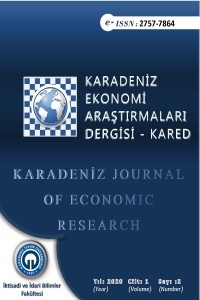Döngüsel Ekonomiye Geçiş: İşletme Stratejilerinde Çevre Koruma Harcamalarının ve Yatırımlarının Önemi
Bu çalışma ile doğrusal ekonomiden döngüsel ekonomiye geçişin önemi vurgulanarak, döngüsel ekonomi için işletmelerin stratejik yönetimlerinde çevre koruma harcamalarının ve çevre koruma yatırımlarının artırılmasının gerekliliğine dikkati çekmek amaçlamaktadır. Çalışmada Türkiye’deki 2013-2021 yılları arasındaki çevre koruma harcamaları ele alınmış, işletmelerin ve devletin çevre koruma yatırımları incelenmiştir. Tahmin değerleri ETS algoritması ile hesaplanmıştır. 2013-2021 yıllarında çevre koruma harcamalarının artan bir seyir izlediği görülmüştür. 2013-2021 yıllarında çevre koruma yatırımlarının genel devlet ve kâr amacı gütmeyen kuruluşların yeterli düzeyde artmadığı, şirketlerin harcamalarında daha fazla artış görülmüştür. 2022-2025 yıllarındaki tahminlere göre toplam harcamalar içinde çevre koruma harcamalarının her bir göstergesinin artan bir seyir izlemesi ve bu eğilimin devam etmesi beklenmektedir. Devlet ve kâr amacı gütmeyen kuruluşların, çevre koruma yatırımlarına daha fazla kaynak ayırması döngüsel ekonomiye geçiş stratejilerinden biri olacaktır. Çalışmanın Türkiye'nin gelecekteki çevre politikaları ve kararları açısından önemli bir kaynak oluşturulduğu ve sürdürülebilir kalkınmaya katkıda bulunulduğu düşünülmektedir.
Anahtar Kelimeler:
Doğrusal Ekonomi, Döngüsel Ekonomi, Sürdürülebilir Kalkınma, Çevrenin Korunması, İşletme Stratejileri
Transition to Circular Economy: Importance of Environmental Protection Expenditures and Investments in Business Strategies
By emphasizing the importance of the transition from the long-term economy to the circular economy with this study, draw attention to the necessity of environmental protection expenditures and environmental protection investments in the investment strategic managements for the circular economy. In the study, environmental protection expenditures in Turkey between the years 2013-2021 were captured, accommodation and environmental protection investments continue. Estimated values are calculated with ETS values. In 2013-2021, an increasing trend was observed in environmental protection expenditures. The fact that the general government and non-profit results of environmental protection investments did not increase sufficiently in the years 2013-2021 explains more of the scene in the expenditures of the enterprises. According to the estimates for the years 2022-2025, the impressions that each indicator of environmental protection expenditures within the total expenditures follows an increasing course and that these excursions continue. Allocating more resources to government and non-profit environmental protection investments will be one of the strategies for transitioning to a circular economy.
Keywords:
Linear Economy, Circular Economy, Sustainable Development, Environmental Protection, Business Strategy,
___
- Antikainen, R., Lazarevic, D., & Seppälä, J. (2018). Circular Economy: Origins and Future Orientations. In H. Lehmann (Ed.), Factor X, Challenges, Implementation Strategies and Examples for a Sustainable Use of Natural Resourves (pp. 115-129): Springer.
- Balbay, S., Sarihan, A. & Avsar, E. (2021). “Circular Economy / Industrial Sustainability” Approach in the World and in Turkey, European Journal of Science and Technology, (27), 557-569.
- Bianco, M. (2018). Circular Economy and WWTPs: Water Reuse and Biogas Production. In A. Gilardoni (Ed.), The Italian Water Industry (pp. 237-257): Springer.
- Biermann, F., Kanie, N., & Kim, R. E. (2017). Global governance by goal-setting: the novel approach of the UN Sustainable Development Goals. Current Opinion in Environmental Sustainability, 26, 26-31.
- Bilgili, M. Y. (2022). Döngüsel Ekonominin Sıfır Atık İdealine Ulaşmada Sunduğu Avantajlar. Döngüsel Ekonomi: Teori ve Pratik, 37.
- Comission, European. (2014). Towards a circular economy: A zero waste programme for Europe, COM/2014/0398 C.F.R.
- Comission, European. (2015). Communication from the Commission to the European Parliament, the Council, the European Economic and Social Committee and the Committee of the Regions—closing the loop—an EU action plan for the Circular Economy.
- Dahlmann, F., Stubbs, W., Griggs, D., & Morrell, K. (2019). Corporate actors, the UN sustainable development goals and earth system governance: A research agenda. The Anthropocene Review, 6(1-2), 167-176.
- Fischer, A. & Pascucci , S. (2017). Institutional Incentives in Circular Economy Transition: The Case of Material Use in the Dutch Textile Industry, Journal of Cleaner Production, 155 (2), 17-32.
- Gedik, Y. (2020). Döngüsel ekonomiyi anlamak: Teorik bir çerçeve. Turkish Business Journal, 1(2), 110-137.
- Hyndman, R.J., Koehler, A.B., Snyder, R.D. & Grose, S. (2002). A State Space Framework for Automatic Forecasting Using Exponential Smoothing Methods. International Journal of Forecasting. 18(3): 439–454.
- Hosagrahar, J., Soule, J., Girard, L. F., & Potts, A. (2016). Cultural heritage, the UN sustainable development goals, and the new urban agenda. BDC. Bollettino Del Centro Calza Bini, 16(1), 37-54.
- Lacy, P., & Rutqvist, J. (2016). Waste to wealth: The circular economy advantage: Springer.
- Liu L., LiangY., Song Q. ve Li J., (2017). A review of waste prevention through 3R under the concept of circular economy in China, Journal of Material Cycles and Waste Management, 19(4):1314-1323.
- MacArthur, E. (2013). Towards the Circular Economy, Economic and Business Rationale for an Accelerated Transition. Ellen MacArthur Foundation: Cowes, UK.
- MacArthur, E. (2013). Towards the Circular Economy, Economic and Business Rationale for an Accelerated Transition. Ellen MacArthur Foundation: Cowes, UK.
- Montaigne, I. (2016). The circular economy: reconciling economic growth with the environment. Retrieved from France.
- Önder, H. (2018). Sürdürülebilir Kalkınma Anlayışında Yeni Bir Kavram: Döngüsel Ekonomi. Dumlupınar Üniversitesi Sosyal Bilimler Dergisi, (57), 196-204.
- Raworth K. (2017). Doughnut Economics: Seven Ways to Think Like a 21st Century Economist, London.
- TÜİK (2022a). Konulara göre çevre koruma harcamaları. https://data.tuik.gov.tr/Bulten/Index?p=Cevre-Koruma-Harcama-Istatistikleri-2021-45520 Erişim Tarihi:25.05.2023
- TÜİK (2022b). Kurumsal sektörlere göre toplam çevre koruma harcamaları. https://data.tuik.gov.tr/Bulten/Index?p=Cevre-Koruma-Harcama-Istatistikleri-2021-45520 Erişim Tarihi:25.05.2023
- TÜİK (2022c). Çevre Koruma Harcama İstatistikleri Bülteni, 2021. https://data.tuik.gov.tr/Bulten/Index?p=Cevre-Koruma-Harcama-Istatistikleri-2021-45520 Erişim Tarihi: 25.05.2023
- Veral, E. S. (2021). Döngüsel ekonomi: Engeller, stratejiler ve iş modelleri. Ankara Üniversitesi Çevrebilimleri Dergisi, 8(1), 7-18.
- Yang Q. Z., Zhou J., & Xu K., (2014). A 3R Implementation Framework to Enable Circular Consum)ption in Community, International Journal of Environmental Science and Development, 5(2):217-222.
- Yayın Aralığı: Yılda 2 Sayı
- Başlangıç: 2020
- Yayıncı: Karadeniz Teknik Üniversitesi
